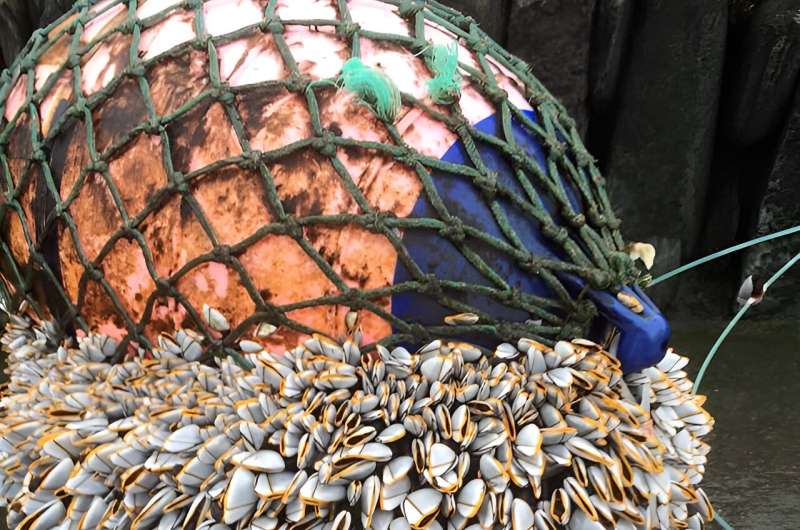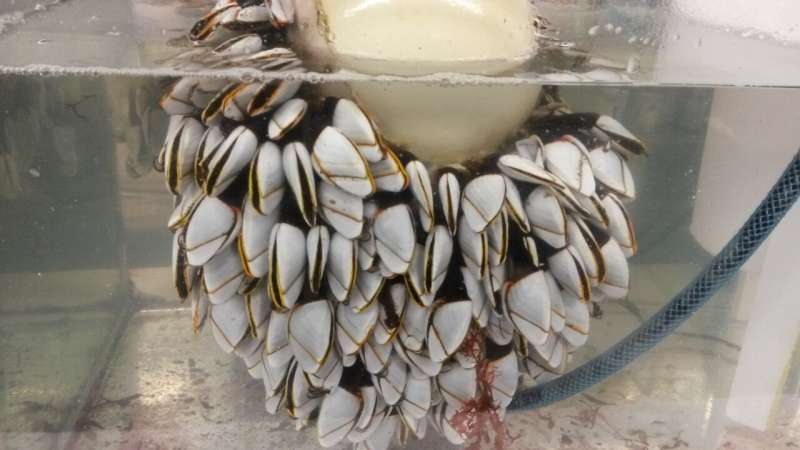This article has been reviewed according to Science X's editorial process and policies. Editors have highlighted the following attributes while ensuring the content's credibility:
fact-checked
peer-reviewed publication
trusted source
proofread
Barnacles may help reveal location of lost Malaysia Airlines flight MH370

A University of South Florida geoscientist led an international team of researchers to create a new method that can reconstruct the drift path and origin of debris from flight MH370, an aircraft that went missing over the Indian Ocean in 2014 with 239 passengers.
Associate Professor Gregory Herbert was inspired the moment he saw photographs of the plane debris that washed ashore Reunion Island off the coast of Africa a year after the crash.
"The flaperon was covered in barnacles and as soon as I saw that, I immediately began sending emails to the search investigators because I knew the geochemistry of their shells could provide clues to the crash location," Herbert said.
As an evolutionary and conservation biologist, Herbert studies marine systems with a particular focus on shelled marine invertebrates, such as oysters, conchs and barnacles. Over the last two decades, Herbert created and refined a method to extract ocean temperatures stored in the chemistry of invertebrate shells. Herbert has used the method previously to determine the ages and extinction risk of giant horse conchs and investigate the environmental circumstances surrounding the disappearance of the Jamestown colony.
Barnacles and other shelled marine invertebrates grow their shells daily, producing internal layers similar to tree rings. The chemistry of each layer is determined by temperature of the surrounding water at the time the layer was formed.
In this study, published in AGU Advances, Herbert's research team did a growth experiment with live barnacles to read their chemistry and for the first time, unlocked temperature records from the shells of barnacles.
After the experiment, they applied the successful method to small barnacles from MH370. With help from barnacle experts and oceanographers at the National University of Ireland Galway, they combined the barnacles' water temperature records with oceanographic modeling and successfully generated a partial drift reconstruction.
"Sadly, the largest and oldest barnacles have not yet been made available for research, but with this study, we've proven this method can be applied to a barnacle that colonized on the debris shortly after the crash to reconstruct a complete drift path back to the crash origin," Herbert said.
Up to this point, the search for MH370 spanned several thousands of miles along a north-south corridor deemed "The Seventh Arc," where investigators believe the plane could have glided after running out of fuel. Because ocean temperatures can change rapidly along the arc, Herbert says this method could reveal precisely where the plane is.
"French scientist Joseph Poupin, who was one of the first biologists to examine the flaperon, concluded that the largest barnacles attached were possibly old enough to have colonized on the wreckage very shortly after the crash and very close to the actual crash location where the plane is now," Herbert said. "If so, the temperatures recorded in those shells could help investigators narrow their search."

Even if the plane is not on the arc, Herbert says studying the oldest and largest barnacles can still narrow down the areas to search in the Indian Ocean.
"Knowing the tragic story behind the mystery motivated everyone involved in this project to get the data and have this work published," said Nassar Al-Qattan, a recent USF geochemistry doctoral graduate who helped analyze the geochemistry of the barnacles.
"The plane disappeared more than nine years ago, and we all worked aiming to introduce a new approach to help resume the search, suspended in January 2017, which might help bring some closure to the tens of families of those on the missing plane."
This research was done in collaboration with Ran Tao, USF spatial geoscientist; Howard Spero, professor emeritus from University of California, Davis; and barnacle experts and oceanographers Sean McCarthy, Ryan McGeady and Anne-Marie Power at the National University of Ireland Galway.
More information: Nasser Al‐Qattan et al, A Stable Isotope Sclerochronology‐Based Forensic Method for Reconstructing Debris Drift Paths With Application to the MH370 Crash, AGU Advances (2023). DOI: 10.1029/2023AV000915
Journal information: AGU Advances
Provided by University of South Florida



















